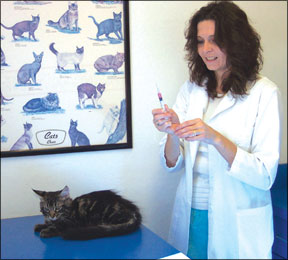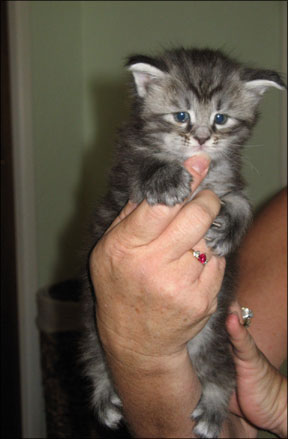Indications that your cat is experiencing a viral infection of its upper respiratory tract – which includes its nose, sinuses, pharynx and larynx – are similar to those that trouble you when you catch a cold: watery eyes, runny nose, wheezing, sneezing and coughing. Just as you are likely to be completely and permanently rid of your cold within a week or so, a cat, in most instances, will also get over the clinical signs of disease within a few days. In some cases, however, serious complications can occur. Bev Caldwell 288 About 80 percent of feline upper respiratory infections are caused by either of two viruses: feline herpesvirus (FHV), also known as feline rhinotracheitis virus (FRV); and feline calicivirus (FCV). A third and far less frequent cause of upper respiratory infections in cats is Chlamydophilia felis, a bacterial agent. “All three of these organisms are very specific to cats,” says Dr. Richard Goldstein, an associate professor of small animal medicine at Cornell Universitys College of Veterinary Medicine. None of these disease agents, he notes, is transmissible to humans or dogs. 
Serious Consequences
The common clinical signs of feline upper respiratory infection may vary from very mild to severe and are, in themselves, usually self-limiting and ultimately harmless, says Dr. Goldstein. Secondary diseases may occur, however, and they can have long-lasting and potentially severe consequences. These consequences include pneumonia, conjunctivitis or corneal ulcers (vision-impairing eye condition) and a host of other bacteria- and virus-borne illnesses resulting from the entry of infectious microorganisms into an afflicted cats system. The most commonly observed of the consequences are chronic sinus infections and chronic nasal discharge following FHV infection.
Although these disease agents are usually passed from cat to cat when they lick or groom one another, they can also be airborne: When sneezing, an infected cat will blow the virus out into the environment, and cats a few feet away will inhale it. A virus can also be transmitted from an unvaccinated, acutely infected queen to her kittens during pregnancy or through grooming after they have been born.
Ongoing Presence
Once present in a cats system, no medication can make the viruses simply disappear. Cats recovered from FCV infection will continue to shed small amounts of virus from their mouths or nose. In time – perhaps after many months or even years, according to Dr. Goldstein – the calicivirus will vanish.
On the other hand, says Dr. Goldstein, the herpesvirus, once present in the feline system, remains forever. Recovered cats will intermittently shed small quantities of virus from their throat or

Bev Caldwell
288
nose. “For the remainder of the animals life,” he says, “the herpesvirus will flare up repeatedly. In cats, these eruptions can be brought on by such things as stress, bad weather, the outbreak of some other illness or medications that suppress the immune system.”
For the past several decades, vaccines have been available that, to a great extent, protect cats against herpesvirus, calicivirus and the Chlamydophilia bacterium. These vaccines have, over the years, proven generally successful in significantly reducing the occurrence and severity of feline respiratory infections. However, outbreaks of these infections continue to threaten the unvaccinated kittens and the feral cat population.
Moreover, since the vaccines only produce partial protection, some domestic cats can become ill despite being properly vaccinated; and others may fail to receive their shots according to a recommended schedule.
Risk Factors
These infections are, in general, rarely fatal; nevertheless, they are especially threatening to some cats. “Any cat can become infected at any age,” says Dr. Goldstein, “but we see the really severe infections in kittens born to queens who have not been inoculated and are left to fend for themselves in wet cold weather. Thats when their resistance is impaired and they are apt to get sick.”
The first milk of a queen that has been inoculated against one of the disease-causing viruses – or has been infected naturally in the past – contains colostrum, a substance rich in antibodies that will provide a kitten temporary protection against viral infection, according to Dr. Goldstein. However, kittens who for some reason are deprived of that protection, he says, “tend to get the disease in its severest form. They can lose their eyes because of ulcers, they may not be able to breathe, and they may die from pneumonia or another secondary infection that goes into their blood.”
On the other hand, a kitten born to a vaccinated queen and living in a dry, warm environment is unlikely to contract an upper respiratory infection even if it is exposed to a viral agent. And even if this kitten does get sick, it will usually be a mild type of illness that lasts for only a few days. But this immunity will eventually wear off, at which point a young cat will become susceptible to infection.
Treating Infection
Diagnosis is achieved by observing the clinical signs, notes Dr. Goldstein. “When you see it, you know its an upper respiratory problem,” he says, “but you dont know for sure which virus has caused it or what kind of bacteria are responsible for a secondary infection. So we most often treat the cat symptomatically, give it antibiotics for a secondary infection, and keep the animal hydrated, fed and comfortable.”
In severe cases, he adds, a herpesvirus may be identified and a medication can then be administered that will shorten the time that the virus is active. There is no such treatment for the calicivirus, however. “It just has to go away by itself,” says Dr. Goldstein.
Whats the best way of protecting your cat against upper respiratory disease? “Make sure it is vaccinated on schedule,” says Dr. Richard Goldstein, “and that the animals environment is clean, dry and warm. This is especially important for kittens. And keep cats of any age indoors as much as possible.”
And whats the proper way to care for your cat if it does show signs of upper respiratory distress? Says Dr. Goldstein: “The most important steps are to keep it dry and warm, make sure it eats, and keep it well hydrated – give it plenty to drink.”



